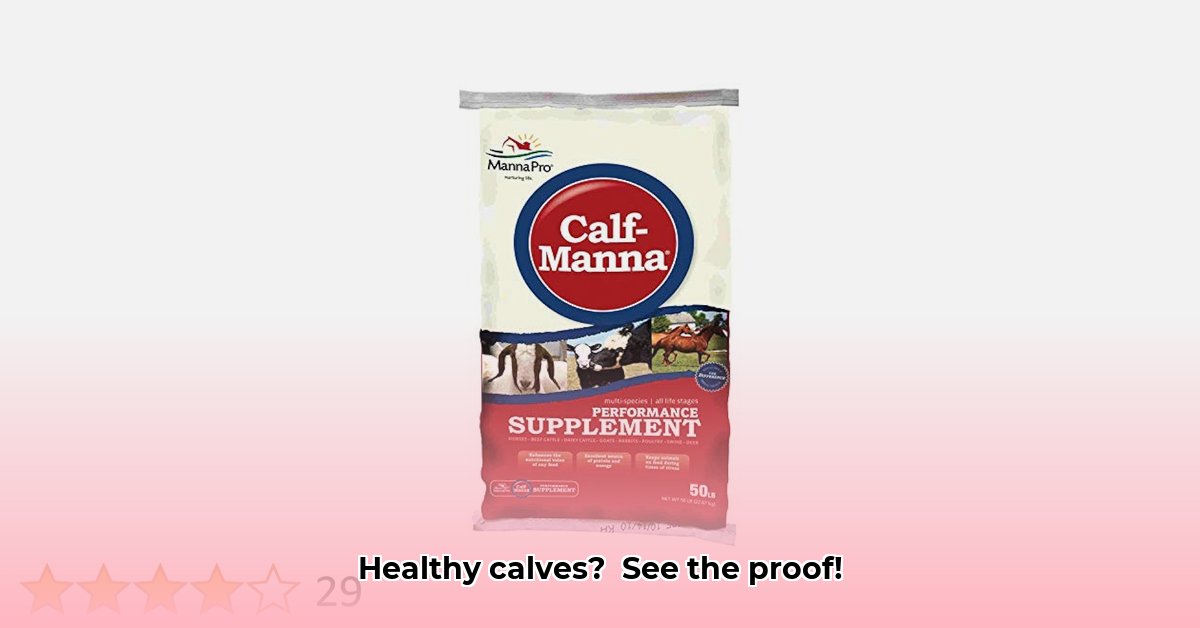
Calf Manna Tractor Supply: A Comprehensive Review
Calf Manna, a supplement readily available at Tractor Supply, promises enhanced health and performance in cattle. This article offers an objective evaluation of Calf Manna, weighing its purported benefits against existing evidence and potential risks. Our analysis incorporates farmer testimonials, manufacturer claims, and considerations for responsible usage. We aim to provide actionable insights for farmers, manufacturers, veterinarians, and regulatory agencies. For added information on similar products, check out Tractor Supply feed options.
Product Overview: Composition and Manufacturer Claims
Calf Manna's formulation includes a blend of protein (minimum 25%), essential amino acids (lysine and methionine), vitamins (A, D3, E), and minerals (calcium, phosphorus, zinc, copper, selenium). The manufacturer, Manna Pro, claims that Calf Manna improves feed intake, enhances overall health, and may positively impact weight gain and milk production in dairy cattle. These claims, however, require rigorous scientific validation.
Evidence Evaluation: Separating Fact from Anecdote
While the guaranteed analysis demonstrates a rich nutrient profile, robust scientific evidence supporting all manufacturer claims remains limited. Many positive experiences are reported anecdotally by ranchers. However, these testimonials lack the rigor of controlled scientific studies.
| Feature | Supporting Evidence | Contradictory Evidence/Data Gaps |
|---|---|---|
| Nutrient Levels | Guaranteed analysis on product label indicates high levels of key nutrients. | Independent laboratory verification across multiple batches is needed. |
| Taste Appeal | Farmer testimonials suggest improved feed palatability and increased consumption. | Controlled studies comparing Calf Manna’s palatability to other feeds are absent. |
| Performance Enhancement | Some ranchers report increased weight gain and milk production in their herds. | Lack of peer-reviewed studies demonstrating statistically significant benefits. |
The absence of extensive scientific research is a significant limitation. While anecdotal evidence suggests potential benefits, these observations should be interpreted cautiously until corroborated by larger-scale, controlled trials.
Actionable Insights: Steps for Stakeholders
To better understand Calf Manna’s true impact, a concerted effort is needed from multiple stakeholders:
For Farmers and Ranchers:
- Implement Controlled Trials: Compare Calf Manna to a control group receiving standard feed, monitoring weight gain, milk yield, and general health metrics. Maintain meticulous records.
- Consult with Veterinarians: Discuss Calf Manna's potential integration into your herd's overall nutritional plan, considering breed-specific requirements and potential risks.
- Cost-Benefit Analysis: Evaluate the economic viability of using Calf Manna, considering its cost relative to other feed options and the observed (or lack of) performance enhancement.
For Manna Pro:
- Invest in Independent Research: Commission rigorous, peer-reviewed studies to validate claims of improved animal health and performance.
- Specify Feeding Guidelines: Provide clear, evidence-based feeding recommendations based on animal age, weight, breed, and production goals.
- Address Sustainability Concerns: Explore sustainable sourcing practices for Calf Manna ingredients to align with environmentally responsible agricultural practices.
For Veterinarians:
- Assess Nutritional Deficiencies: Evaluate the potential role of Calf Manna in addressing specific nutritional gaps in cattle diets under their care.
- Monitor for Adverse Reactions: Pay close attention to potential side effects, especially copper toxicity, given Calf Manna's copper content.
For Regulatory Agencies:
- Establish Safety Guidelines: Develop guidelines for the safe and effective use of Calf Manna, particularly regarding copper levels to prevent toxicity.
- Promote Transparency: Encourage manufacturers to clearly disclose ingredient sources and complete nutrient profiles.
Risk Assessment: Potential Drawbacks and Mitigation Strategies
Potential risks associated with Calf Manna usage should be carefully considered:
| Risk Category | Likelihood | Severity | Mitigation Strategies |
|---|---|---|---|
| Copper Toxicity | Moderate | High | Adhere strictly to recommended feeding rates. Monitor copper levels in the herd. |
| Insufficient Data | High | Moderate | Demand rigorous scientific studies to validate manufacturer claims. |
| Variable Results | Moderate | Low | Use standardized feeding protocols for consistent results. |
| Ingredient Sustainability | Moderate | Moderate | Support manufacturers committed to sustainable sourcing. |
Conclusion: A Call for Continued Research and Responsible Use
While Calf Manna shows promise as a nutritional supplement for cattle, the lack of comprehensive scientific data warrants cautious optimism. Further research is essential to validate its effectiveness and long-term implications. Responsible usage, guided by veterinary advice and adherence to manufacturer guidelines, is crucial for minimizing potential risks. Continuous monitoring and data collection by farmers and ranchers will contribute significantly to a more complete understanding of Calf Manna's true impact on cattle health and productivity.